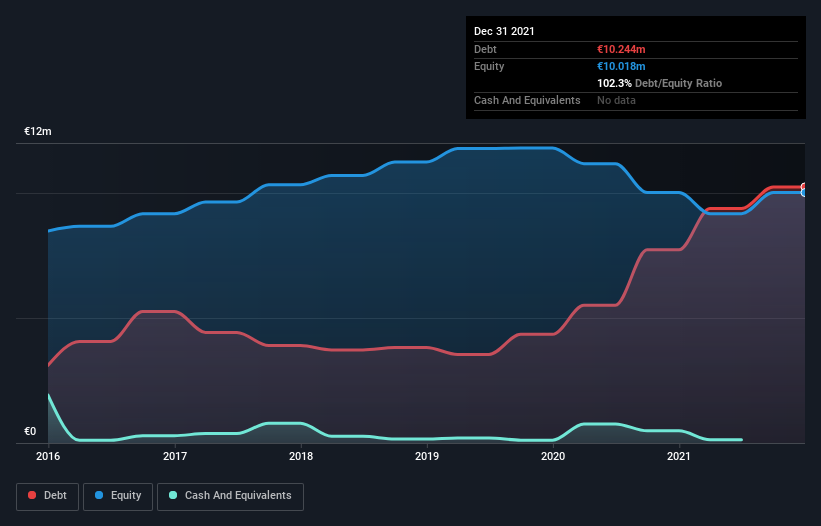Howard Marks put it nicely when he said that, rather than worrying about share price volatility, 'The possibility of permanent loss is the risk I worry about... and every practical investor I know worries about.' So it might be obvious that you need to consider debt, when you think about how risky any given stock is, because too much debt can sink a company. We note that Gambero Rosso S.p.A. (BIT:GAMB) does have debt on its balance sheet. But the more important question is: how much risk is that debt creating?
When Is Debt Dangerous?
Debt and other liabilities become risky for a business when it cannot easily fulfill those obligations, either with free cash flow or by raising capital at an attractive price. Ultimately, if the company can't fulfill its legal obligations to repay debt, shareholders could walk away with nothing. However, a more frequent (but still costly) occurrence is where a company must issue shares at bargain-basement prices, permanently diluting shareholders, just to shore up its balance sheet. By replacing dilution, though, debt can be an extremely good tool for businesses that need capital to invest in growth at high rates of return. When we examine debt levels, we first consider both cash and debt levels, together.
Check out our latest analysis for Gambero Rosso
What Is Gambero Rosso's Debt?
The image below, which you can click on for greater detail, shows that at December 2021 Gambero Rosso had debt of €10.2m, up from €7.73m in one year. Net debt is about the same, since the it doesn't have much cash.

How Strong Is Gambero Rosso's Balance Sheet?
We can see from the most recent balance sheet that Gambero Rosso had liabilities of €13.5m falling due within a year, and liabilities of €8.63m due beyond that. Offsetting these obligations, it had cash of €129.0k as well as receivables valued at €7.96m due within 12 months. So it has liabilities totalling €14.0m more than its cash and near-term receivables, combined.
This deficit casts a shadow over the €5.55m company, like a colossus towering over mere mortals. So we definitely think shareholders need to watch this one closely. At the end of the day, Gambero Rosso would probably need a major re-capitalization if its creditors were to demand repayment.
In order to size up a company's debt relative to its earnings, we calculate its net debt divided by its earnings before interest, tax, depreciation, and amortization (EBITDA) and its earnings before interest and tax (EBIT) divided by its interest expense (its interest cover). Thus we consider debt relative to earnings both with and without depreciation and amortization expenses.
Gambero Rosso's debt is 2.8 times its EBITDA, and its EBIT cover its interest expense 4.8 times over. This suggests that while the debt levels are significant, we'd stop short of calling them problematic. Notably, Gambero Rosso made a loss at the EBIT level, last year, but improved that to positive EBIT of €751k in the last twelve months. When analysing debt levels, the balance sheet is the obvious place to start. But it is Gambero Rosso's earnings that will influence how the balance sheet holds up in the future. So if you're keen to discover more about its earnings, it might be worth checking out this graph of its long term earnings trend.
But our final consideration is also important, because a company cannot pay debt with paper profits; it needs cold hard cash. So it's worth checking how much of the earnings before interest and tax (EBIT) is backed by free cash flow. During the last year, Gambero Rosso burned a lot of cash. While that may be a result of expenditure for growth, it does make the debt far more risky.
Our View
To be frank both Gambero Rosso's conversion of EBIT to free cash flow and its track record of staying on top of its total liabilities make us rather uncomfortable with its debt levels. But at least its EBIT growth rate is not so bad. Taking into account all the aforementioned factors, it looks like Gambero Rosso has too much debt. That sort of riskiness is ok for some, but it certainly doesn't float our boat. The balance sheet is clearly the area to focus on when you are analysing debt. However, not all investment risk resides within the balance sheet - far from it. For example Gambero Rosso has 4 warning signs (and 3 which are a bit concerning) we think you should know about.
Of course, if you're the type of investor who prefers buying stocks without the burden of debt, then don't hesitate to discover our exclusive list of net cash growth stocks, today.
New: Manage All Your Stock Portfolios in One Place
We've created the ultimate portfolio companion for stock investors, and it's free.
• Connect an unlimited number of Portfolios and see your total in one currency
• Be alerted to new Warning Signs or Risks via email or mobile
• Track the Fair Value of your stocks
Have feedback on this article? Concerned about the content? Get in touch with us directly. Alternatively, email editorial-team (at) simplywallst.com.
This article by Simply Wall St is general in nature. We provide commentary based on historical data and analyst forecasts only using an unbiased methodology and our articles are not intended to be financial advice. It does not constitute a recommendation to buy or sell any stock, and does not take account of your objectives, or your financial situation. We aim to bring you long-term focused analysis driven by fundamental data. Note that our analysis may not factor in the latest price-sensitive company announcements or qualitative material. Simply Wall St has no position in any stocks mentioned.
About BIT:GAMB
Gambero Rosso
Operates as a multimedia and multichannel platform for communication, promotion, and training in agricultural, agri-food, hospitality, and related sectors in Italy.
Slight risk and slightly overvalued.
Market Insights
Community Narratives



